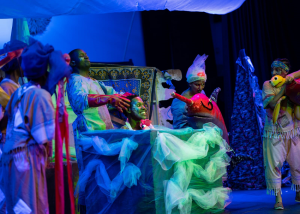KenyaBuzz interviews Creative Director Kasia Mesazaros.
What inspired you to adapt Maciej Ochalik's book, "Leo's Search for a New Home," into a theatrical production, and what drew you to the story of Leo the sea turtle?
It's a beautiful, heart-warming story with clear characters, simple but strong storyline and a lovely main character, cute turtle, that children can associate with. It's a perfect book for puppet theatre.
Could you share some insights into the creative process behind designing and sourcing the lifelike puppets for the show? What challenges did you face, and how did you overcome them?
The puppets were designed by a professional puppet designer from Poland, Martyna Dworakowska, but most of them were made in Kenya. The challenging part was to find the right materials and people who understand the mechanisms and finesse of the designs. We worked with Kenya Institute of Puppet Theatre, but also Maciej Ochalik, the author of the book, prepared the whale puppet.
Few puppets came in pieces from Poland from a professional puppet workshop. It's a real international cooperation. In addition I chipped in my ideas and added traditional Kenyan fabrics onto the body of the puppets, kitenge and leso, to connect the two worlds, European Union and Kenya.
The puppets in the show represent the beautiful idyllic colorful sea world without any plastic, past and hopefully the future world. The actors are wearing grey, dark blue and beige colors as the representatives of the plastic community of the planet. The colors are inspired by the pictures of the plastic waste mountains around the world.
As both the director and a passionate advocate for environmental sustainability, how do you balance the artistic elements of the production with the underlying message of conservation and stewardship?
The audience will tell;) When writing the script together with the author of the book, Maciej Ochalik, we wanted to create a story about friendship, teamwork and hope, with the environmental background.
On stage I am emphasizing a lot the garbage patch floating on the oceans, I want to show people it's a real problem that truly can kill the lives of the sea creatures they associate with when watching the show. We're not teaching the kids how to recycle plastic or paper. But we do show them a real impact on their new sea friends if they throw a plastic bottle into the ocean next time they're in Mombasa.
We understand that you have a background in theater. How has your theatrical experience influenced your approach to directing "Leo's Search for a New Home," particularly in terms of engaging audiences of all ages and backgrounds?
I have an MA degree in arts. I studied acting and puppetry for 4 years in Poland, Theatrical Academy in Warsaw, Puppetry Faculty in Białystok, one of the best puppetry schools in the world. I worked 8 years in the professional theatre in Cracow (Groteska Theatre), and in 2015 I moved to Kenya. In Poland I performed on stage, now in Kenya I decided to be a director and share my knowledge on theatre with those who are interested in developing themselves as actors in Kenya.
Now I have set up my own puppet theatre called Karagozi Theatre. I'm planning to continue work and prepare the shows for both children and adults.
Just to reveal some secrets of the March shows, the audience will see me on stage, as part of the cast.

The incorporation of Kiswahili into the show adds a unique and culturally relevant dimension. Can you tell us more about the decision to include Kiswahili and how you believe it enhances the audience's connection to the story and its themes?
Since we are doing theatre in Kenya, for the Kenyan audience, I can't imagine not including Kenyan cultural elements in the show. We are performing for the Kenyan children who speak Kiswahili but also it works great with the international audience as we're trying to keep the right balance between English and Kiswahili. Kiswahili is a beautiful language that sounds fantastic when singing as well as contributes to the rhythm of the show.
Tickets on KenyaBuzz




